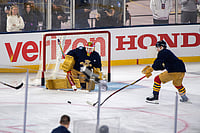On a stormy July evening in Imphal, the Chanu household sat glued to the telly, praying silently for one simple thing—that there should be no power cuts for the next couple of hours in the day. The electricity did not trip that day, and they could watch their daughter Sanamacha win three weightlifting golds in the 53 kg category at the recent Manchester Commonwealth Games. The gods were kind to them and memories of a bitter failure at the Sydney Olympics in 2000 had no place to come back in the celebrations that followed.
Twenty-four hours earlier, another family in the neighbourhood was partying, for a similar feat. N. Kunjarani Devi had once again found her magical touch to pick up three golds in the 48 kg category. But Manipur's contribution to India's unprecedented success at Manchester did not stop with these two. India's women's hockey team, which showed uncharacteristic grit to take the podium with a golden goal, was led by a Manipuri, W. Surjalata Devi. Three others in the team—goalkeeper Ksh. Tingonleima, Pakpi Devi and M. Sangai Ibehmal Chanu—all belonged to the state. And in the euphoria that followed India's medal haul, few realised that seven out of the 32 golds at Manchester were mopped up by players from this tiny insurgency-wracked north-eastern state.
In Imphal, however, no one was surprised with the super show. "Manipur's boys and girls have always done well in sports over the years. It's only that they have come into the limelight now," says state sports minister A. Aza. Besides the medal winners, others who went to Manchester include boxer N. Dingko Singh (Asian gold medallist in 1998), and judokas A. Anita Devi and L. Brojeshwari.
So what makes a tiny state with a small population of 23 lakh a sports powerhouse—producing more than 150 international and over 500 national players in the past 20 years? Theories abound on this trend. Says Olympian Thoiba Singh, a regular in the national men's hockey team in the '80s: "Manipuris are blessed with two advantages—a compact and athletic physique, and an even climate through the year which is very conducive for different sports." Agrees L. Ibomcha Singh, a former armyman-turned-Sports Authority of India (SAI)-trained boxing coach: "Since ancient times we Manipuris have been good at sports. Earlier we played indigenous games, now we excel in contact sports." Journalist Yumnam Rupachandra says sports helps Manipuris escape the drudgery and poverty in the state. "Excelling in sports gives Manipuris a chance to move higher up in life."
Rupachandra's theory is borne out by the fact that all the gold medal-winning Manipuris have jobs outside the state. While Kunjarani and Sanamacha are employed by the Central Reserve Police Force (CRPF), all the women hockey players serve in the Indian Railways. At least half-a-dozen footballers play in cash-rich clubs like Dempo, Salgaocar and Churchill Brothers, earning over Rs 5 lakh annually. Even Thoiba Singh and Olympian Neelkamal Singh are employed with the Food Corporation of India and Indian Airlines respectively. A natural exodus considering Manipur's ailing economy which prevents the local government from providing any incentives or jobs to its sportspersons. Says sports commissioner B. Singh: "We cannot commit anything at the moment since the state coffers are empty."
In fact, a cash incentive scheme for medal winners in national and international meets is on hold for the past five years. Various sports associations of the state are routinely refused grants for sending teams to national events. "Many officials are running their units by mortgaging their own properties," says a senior government official.
Yet, Manipur churns out champions in as varied sports as football and archery. Says Ch.Shanti Kumar Singh, technical director of the Manipur Football Association and a national-level coach: "We are naturally gifted to do well in sports. Look at our footballers. We don't have proper facilities or sponsorship, but we are still among the top 4-5 teams in the country. If all our players who have migrated to other states are allowed to play in the Manipur team, we are good enough to beat the best." Singh should know. With a diploma in football coaching from Brazil, he has been at the helm of Manipur football for the past 10 years. In October later this year, he hopes to win the all-India Santosh Trophy, when the state plays host to it for the first time. His job will be made easier by a change in the rules of players' participation. "Footballers playing outside their home state can now play for their respective states if called for duty. So we are counting on at least 10 such boys who are away from Manipur," he says. Four Manipuri players were, in fact, part of the Indian football team under Baichung Bhutia that won the six-nation LG Cup in Vietnam last week. Shanti Kumar Singh's now confident that Manipur's time to be counted among the top two football powers in the country, along with Kerala, has arrived.
The SAI has also contributed its bit by sending trained coaches back home to Manipur. But clearly, it has woken up to the state's potential only now. After the Commonwealth Games success, C.R. Gopinath, SAI's executive director (operations), rushed to Imphal to review the facilities. Encouraged by the success of Manipuri players, the SAI has now decided to focus its attention on contact sports and hockey.
The decision is clearly fuelled by the fact that football and weightlifting are not the only sports Manipuris are interested in. A visit to the Khuman Lampak Sports complex reveals over 800 boys and girls practicing and honing their skills in as many as 19 disciplines—from hockey to fencing and cycling to sepak teraw, a popular southeast Asian ballgame. The skills and dedication of coaches, players and officials is exemplary. Take Gunicha Devi, for instance. A former international archer and now Manipur's chief archery coach, she belongs to a family that has produced at least half-a-dozen international archers. But there is little or no support from the government. "We have to bear our own travelling cost," she says. "Each fibreglass bow and arrow costs at least Rs 80,000, an amount our association cannot afford. Often we contribute personally or our families chip in."
Indeed, one significant contribution to the state's rise as a sports powerhouse comes from the local clubs and community network. Says Thoiba Singh: "Since all of us start our careers at the local clubs, in times of distress we go back to our clubs and local people contribute generously. This is our major strength. Even if we don't have anybody sponsoring our teams, the efforts of clubs and local communities sees us through."
That and the fierce sense of pride in everything they do makes Manipur's gritty sportspeople a power to reckon with in India's fickle sporting world.
Nor'Easter, It's A Fair Wind Blowing
Manipur picked up seven of India's 32 golds at Manchester. What makes athletes from this insurgency-infested state tick?

Nor'Easter, It's A Fair Wind Blowing
Nor'Easter, It's A Fair Wind Blowing
Published At:
- Previous Story
 Kalinga Lancers SWOT Analysis Ahead Of Men's Hockey India League 2026 - All You Need To Know
Kalinga Lancers SWOT Analysis Ahead Of Men's Hockey India League 2026 - All You Need To Know - Next Story
MOST POPULAR
WATCH
MORE FROM THE AUTHOR
×

















